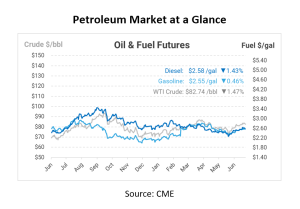
Preparing for Hurricanes – Part 2: After the Storm
After a hurricane passes, it will likely leave a trail of uncertainty and challenges in its wake. While the skies may have cleared, the real work of recovery will just begin. In our previous article, “Preparing for Hurricanes – Part 1: Before the Storm,” we provided you with essential steps to stay ahead of storms. Now, it’s time to focus on what happens next: navigating the complex and often daunting aftermath.
In today’s article, we’ll explore the steps to resume your operations faster. From assessing damage and ensuring the safety of your team to managing fuel supplies and coordinating with emergency services, our comprehensive guide will help you tackle the post-storm landscape with confidence.
After the Storm
1 – Communicate with Your Fuel Supplier
Communication is crucial before, during, and after a storm to ensure your fuel supplier can meet your delivery needs. Maintaining regular contact to provide updates on site openings, post-storm demand levels, and other relevant information is essential to ensure a steady fuel supply. Additionally, make sure to inform your supplier if your site has lost power, as it is typically required to pump fuel.
2 – Check Tanks for Water
Use your Automatic Tank Gauge (ATG), stick, or water-finding paste to detect any excess water in your fuel tanks. If you find significant amounts of water (1 inch or more), do not order or dispense fuel. Instead, contact your fuel supplier and arrange to have the contaminated fuel removed. Using or selling fuel with a water content can damage vehicles and equipment and result in costly repairs.
3- Check Inventory Levels
Before placing a fuel order, verify your inventory levels to ensure there is enough space for the delivery. Recheck the levels on the day of delivery and communicate any changes to your supplier. This helps prevent issues in the fuel supply chain and avoids potential freight penalties or environmental risk due to overfilled tanks.
4 – Confirm Trucks Are in Working Order
If your trucks were relocated or affected by the storm, it might change your usual demand requirements. Report any concerns about damaged equipment to your fuel supplier. They can help assess the impact on demand and fuel consumption and ensure you receive the necessary support.
5 – Discuss Replenishment Schedules
For sites requiring fuel for generator power, it’s essential to communicate the consumption rates to your supplier. This information helps them plan and dispatch fuel deliveries effectively, keeping the generators and other equipment up and running until the power’s back on.
Stay Ready!
As hurricane seasons become more unpredictable, the importance of preparedness cannot be overstated. By following these guidelines, you can resume operations faster than might have otherwise been possible. Clear communication with your fuel supplier, careful monitoring of fuel quality and inventory, and ensuring your equipment is in good working order are essential.
Do not forget that storm preparedness and a well-structured and robust Emergency Response Fuel Program are crucial to protecting your vehicles and equipment in case of any natural disaster or emergency that arises.
Not sure how to implement your Emergency Plan? Talk to the experts!
Mansfield Energy, North America’s leading fuel distributor, brings a wealth of expertise to the table in creating a robust emergency response program tailored to your company’s needs. With an extensive network servicing the US and Canada, Mansfield understands the critical importance of proactive measures in facing potential disruptions caused by hurricanes or other natural disasters.
Leveraging in-depth knowledge, Mansfield has developed a comprehensive Emergency Response Fuel Program that prescribes industry best practices. Mansfield’s program enables a multi-faceted approach, prioritizing essential services and collaborating closely with partners to ensure seamless fuel distribution during emergencies. Contact us today!

This article is part of Daily Market News & Insights
Tagged: after the storm, Hurricane season, hurricanes, part 2, Storm Season
MARKET CONDITION REPORT - DISCLAIMER
The information contained herein is derived from sources believed to be reliable; however, this information is not guaranteed as to its accuracy or completeness. Furthermore, no responsibility is assumed for use of this material and no express or implied warranties or guarantees are made. This material and any view or comment expressed herein are provided for informational purposes only and should not be construed in any way as an inducement or recommendation to buy or sell products, commodity futures or options contracts.





